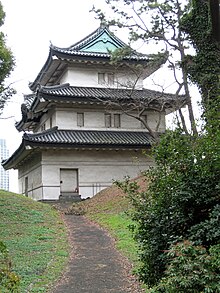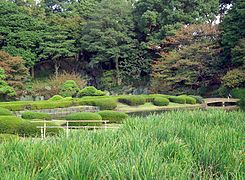Kōkyo Higashi-gyoen
Kōkyo Higashi-gyoen ( Japanese 皇居 東 御苑 'Imperial East Garden of the Imperial Palace' ) is the publicly accessible eastern part of the Imperial Palace or the old castle grounds of Edo Castle . It includes the castle districts of Honmaru, Ni-no-maru and a small part of San-no-maru.
Kitanomaru Park is now located on the northern part of the former castle grounds .
history
After the Meiji restoration and the takeover of Edo Castle by the imperial family, the western part ( Ni-no-maru ) was used and the new residence was built there. The old castle grounds were used, but a large part of it was prepared as a park for the public. The redesign of the eastern part of the imperial residence began in 1961 with the demolition or relocation of buildings that had stood there since the Meiji period . A new pond was created in the Ni-no-maru and buildings from the Edo period were repaired or restored . After completion in 1963, the entire complex was given the status of “Important Historical Traces” ( 史跡 , shiseki ) within the law on the protection of cultural assets .
The garden can be entered through the three gates Ōtemon ( 大 手 門 ), Hirakawamon ( 平川 門 ) and Kitahanebashimon ( 北 桔 橋 門 ).
Ninomaru garden
If you have passed the Ōtemon, you pass the flat buildings of the guards Dōshin bansho ( 同心 番 所 ), Hyakunin bansho ( 百 人 番 所 ) and finally Dabansho ( 大 番 所 ) on the way to Honmaru . On the way up you pass the remains of a castle gate, Naka-no-mon ( 中 之 門 ) and finally the Chūjakumon ( 中 雀 門 ), also Genkanmaemon ( 玄関 前門 ).
In the Ni-no-maru the remainder of an inner ditch has been preserved under the name Tenjin-bori ( 天神 濠 ), but otherwise this part has been largely redesigned compared to the Edo period. In the north there are plum trees on the slope, followed by an area in which all 47 prefectures are represented with their prefectural tree. There are 260 trees, but only 30 different species, as some prefectures have chosen the same tree. Another grove also contains various trees. An iris field adjoins a garden with a pond. Two buildings are worth highlighting:
- The Museum of the Imperial Collection. The Museum San-no-maru Shōzōkan ( 三 の 丸 尚 蔵 館 ), opened in 1993, houses paintings from the premodern period, writings, handicrafts and paintings from the present.
- The Suwa no Chaya ( 諏 訪 の 茶屋 ) tea house on Tenjin-bori was located in the Fukiage area during the Edo period. It was taken to the Akasaka Palace and finally transferred to this garden area.
Honmaru
There is nothing left of the extensive former residence, it is now occupied by lawns. On the southwestern edge, a stone indicates the handling of Matsu-no-Ōrōka , in which the 1701 incident that led to the vengeance of the 47 samurai took place. From the Edo period are preserved:
- Base of the keep ( Tenshukaku ) ( 天 守 台 , Tenshudai )
- Watchtower Fujimi-yagura ( 富士 見 櫓 )
The following buildings are from more recent times:
- Tōkagakudō concert hall ( 桃 華 楽 堂 , "peach blossom hall"). It was built to celebrate Empress Kōjun (March 6, 1963). The hall has an octagonal shape, is made of reinforced concrete and has an area of 1254 m². The outer walls are decorated with mosaics. Construction, started in 1964, was completed in 1966.
- Performance hall for traditional Gagaku music ( 楽 部 庁 舎 , Rakubu chōsha )
- Archives of the Imperial House ( 書 陵 部 庁 舎 , Shorōybu chōsha )
Characteristics
- Administration: Ministry of the Environment manages the facility as a public park ( 国民 公園 , Kokumin Kōen)
- Opening: 1963
- Access: Three gates Ōtemon, Hirakawamon and Kitahanebashimon
- Size: 210,000 m²
- Admission: Admission is free, you get a plastic token, which you have to hand in when you leave.
gallery
Pair of lions by Kanō Eitoku in the Imperial Collection
literature
- Tokyo-to rekishi kyuiku kenkyukai (ed.): Tokyo-to no rekishi sampo (jo) . Yamakawa, 2001, ISBN 4-634-29130-4 .
Web links
- Website of the garden at the Imperial Court Office (Japanese)
Coordinates: 35 ° 41 ′ 11 " N , 139 ° 45 ′ 27" E











